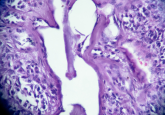Novel urine test for early lung cancer detection

MIT (MA, USA) have developed a technology that may revolutionize lung cancer screening, offering a simpler and more accessible method for early detection. The innovative diagnostic relies on nanoparticle sensors delivered through an inhaler or nebulizer. When these sensors encounter cancer-associated proteins in the lungs, they produce a signal that accumulates in urine, detectable through a straightforward paper test strip.
This novel approach could potentially complement or serve as an alternative to the existing gold standard for diagnosing lung cancer, namely low-dose computed tomography (CT). Its primary advantage lies in its potential to address the global rise of cancer in low- and middle- income regions driven by factors like pollution and smoking. In such areas, where access to CT scanners is limited, this novel diagnostic method could significantly impact early cancer detection.
The conventional approach for early lung cancer detection involves yearly CT scans for individuals aged 50 or older who are heavy smokers. However, not everyone in this demographic opts for these scans, as the possibility of potential false positives may result in unnecessary invasive procedures.
MIT’s nanoparticles, designed for earlier use in liver and ovarian cancer and previously delivered intravenously, have now been adapted for inhalation, making them more accessible in resource-limited settings. The particles, covered with a reporter such as a DNA barcode, are administered either through an aerosolized solution or dry powder, where they encounter proteases in the lungs. These proteases (particularly overactive in tumors) cleave DNA barcodes from the sensors, which then accumulate in urine for detection.
The researchers assessed the accuracy of the diagnostic in genetically engineered mice with lung tumors resembling those found in humans. Utilizing a machine learning algorithm, they pinpointed a combination of four different protease sensors that accurately identified early-stage lung tumors.
The next steps for the team involve examining human biopsy samples to assess the sensor’s effectiveness in detecting human cancers. They also aim to initiate clinical trials, envisioning broad applications in areas with limited access to CT scanning.
This revolutionary technology not only simplifies the screening process but also holds the promise of offering rapid results during a single visit, potentially leading to life-saving interventions and treatments.





